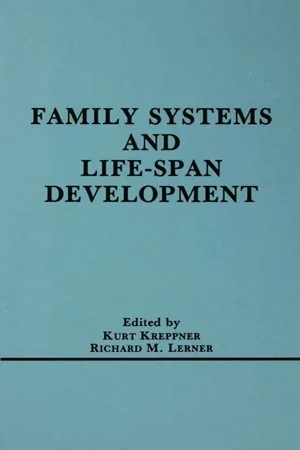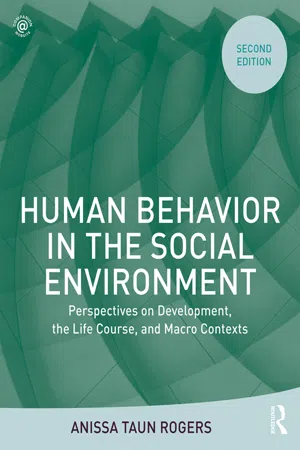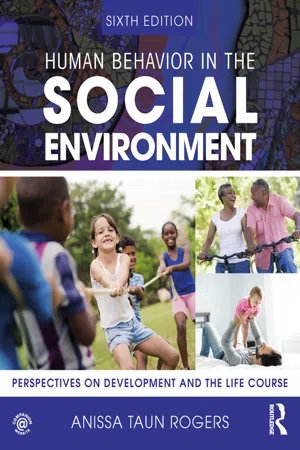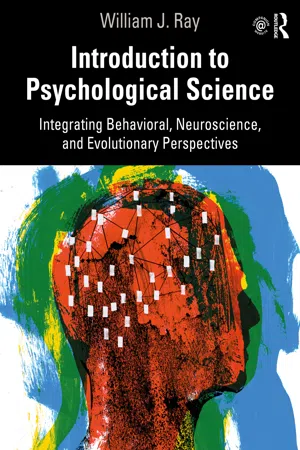Psychology
Infant Development
Infant development refers to the physical, cognitive, and socio-emotional changes that occur in babies from birth to age 2. This period is marked by rapid growth and development across various domains, including motor skills, language acquisition, and social interaction. Understanding infant development is crucial for identifying potential developmental delays and providing appropriate support for healthy growth and learning.
Written by Perlego with AI-assistance
Related key terms
Related key terms
1 of 4
Related key terms
1 of 3
10 Key excerpts on "Infant Development"
- eBook - ePub
Companion Encyclopedia of Psychology
Volume Two
- Andrew M. Colman(Author)
- 2019(Publication Date)
- Routledge(Publisher)
8DEVELOPMENTAL PSYCHOLOGYINTRODUCTION
This section cuts across the others inasmuch as it is concerned with the development, across the lifespan from birth to old age, of all aspects of behaviour and mental experience dealt with in the other sections, including biological aspects of behaviour (section 2), sensation and perception (section 3), cognition (section 4), learning and skills (section 5), emotion and motivation (section 6), individual differences and personality (section 7), social behaviour (section 9), and psychopathology (section 10). The crossreferences are too numerous to list exhaustively, because this section is conceptually parasitic on most of the others rather than being concerned with its own class of behavioural or mental phenomena.Developmental psychology is strongly influenced by the work of the Swiss psychologist, philosopher, and biologist Jean Piaget (1896–1980). Piaget’s main concern was the development of thinking, but his ideas, though highly controversial, pervade almost all areas of developmental psychology, and aspects of his work are discussed in every chapter in this section. There is no other major branch of psychological research that is so strongly influenced by the writings of a single individual.Chapter 8.1 by George Butterworth is on infancy. Infancy (whose Latin roots mean “not speaking”) is usually taken in developmental psychology to denote the period between birth and the acquisition of language, that is, approximately the first 18 months of life. This often causes confusion, because in everyday usage the word is often used loosely to include pre-school children up to 6 or 7 years of age. Butterworth discusses the development during infancy — the first 18 months — of perception, skilled behaviour, knowledge of physical objects and people, and language.In chapter 8.2 - eBook - ePub
Forensic Psychiatry
Fundamentals and Clinical Practice
- Basant Puri, Ian H. Treasaden, Basant Puri, Ian H. Treasaden(Authors)
- 2017(Publication Date)
- CRC Press(Publisher)
8Developmental psychology
NATHALIA L. GJERSOE AND CATRIONA HAVARD Introduction Cognitive development Personality Social development Sexual development The child as witness Conclusion ReferencesINTRODUCTION
Developmental psychology is a discipline that encapsulates the full spectrum of psychological processes throughout the life span. Theories developed as part of this research have important implications not just for our understanding of children’s behavior and growth but also for how we conceptualize the human mind as a whole. Often there are processes so inextricably interwoven and sophisticated in adults that understanding them requires examination from their inception in the developing brain. This chapter focuses on the age range between infancy and late childhood and summarizes theories of children’s cognitive, personality, social, and sexual development, concluding with an outline of current opinion regarding children’s capacities as eyewitnesses.COGNITIVE DEVELOPMENT
Even newborns come into the world with a toolkit of basic sensory capacities and biases to attend to specific types of information. This stream of information forms the basis for mental representations—patterns of neuronal activity that refer to aspects of the external world. Developmental cognitive psychology examines mechanisms of change in mental representations throughout the life span. Examining cognitive development in infants and young children requires its own set of methodologies distinct from those used to examine adults. Children have limited communication and -comprehension abilities, disorganized or slow motor responses, and are easily distracted. Traditionally, research into cognitive development utilized naturalistic observation of children’s behavior at different ages and manipulated situations to determine if children’s responses changed in a reliable manner from age to age. This work has revealed a host of cognitive capabilities that all typically developing children seem to attain within a very similar time period—referred to as cognitive milestones - eBook - ePub
- Nancy Fenton, Jessica Flitter, Jessica Flitter(Authors)
- 2015(Publication Date)
- Research & Education Association(Publisher)
Chapter 11 Developmental PsychologyDevelopmental psychology focuses on the physical, cognitive, social, and moral development of humans that occurs across the lifespan from conception to death. Typically developmental psychologists examine these various changes at distinct periods in life, in particular, prenatal and newborn, childhood, adolescence, and adulthood. Developmental psychologists are ultimately attempting to answer questions about how we become who we are and how much of whom we are is related to nature and how much is influenced by nurture. In regard to developmental psychology, the term nature specifically references influences on development that are genetic or biological. Aspects of developmental change influenced by nature are often related to the process of maturation. Maturation includes the biological growth processes that enable changes in behavior. These growth processes are connected to an individual’s genetic blueprint, meaning that they are relatively uninfluenced by experience. The term nurture involves the influence of environmental factors on development, such as family, nutrition, culture, interactions with others, education, wealth, etc. Developmental psychologists agree that both nature and nurture contribute to physical, cognitive, social, and moral development in people.STUDY TIPBe able to describe how nature and nurture influence physical, cognitive, social, and moral development.Developmental Research MethodsDevelopmental psychologists seek to understand how individuals develop over time and determine whether differences among age groups are related to changes in cognitive, emotional, or behavioral abilities; for example, if older children can remember longer lists of words than younger children. Because age cannot be manipulated (individuals cannot be randomly assigned to a particular age group), developmental research is often correlational. - eBook - ePub
Bringing Up Baby
The Psychoanalytic Infant Comes of Age
- Dianna T. Kenny(Author)
- 2018(Publication Date)
- Routledge(Publisher)
Chapter SixThe modern infant: enter developmental neuroscience
“The ego begins as a ‘state’ ego, rather than a body ego” (Sander, 1962, p. 20)Developmental neuroscience and infant observation jointly provide a foundation upon which theorising about Infant Development can be progressed, verified, modified, or rejected. Advances in our understanding of the unconscious, primarily via developments in cognitive and memory research, the development of attachment theory and its underlying neurobiology, and infant observation methods have each been pivotal in integrating the scientific investigation of human development and behaviour, psychoanalytic theory and practice, and the study and understanding of infancy. An integration of the apparently diverse disciplines of neuroscience, psychoanalysis, and infant research offers the best hope of understanding infancy and, indeed, the infant that resides within all of us. In this final chapter, we will work at the intersections of these three disciplines to develop a nuanced, scientifically verifiable conceptualisation of the human infant.Sander’s (1962) comment above is a good starting point for this discussion because it acknowledges the infant’s capacity for inner experience from birth. Beginning with the repertoire of affective states on the sleep-wake continuum, the infant organises and internalises his conscious experiences or “states”, which represent configurations of the functioning of the organism during particular experiences. The term “state” appears frequently in infant research literature in its various forms, depending on which part of the system is involved; for example, mental states (Fonagy, 1989), emotional states (Tomkins, 1991), self-states (Yerushalmi, 2001), and interpersonal states or representations of interactions that have generalised (RIGs) (Stern, 1985) or “schemas-of-being-with-another” (Stern, 1994, 1995). - eBook - ePub
- C.W. Valentine(Author)
- 2015(Publication Date)
- Routledge(Publisher)
General facts as to early development . In considering the stages of development of the child, several general facts and principles must be borne in mind.First, there is no definite break between the various periods, say of babyhood, infancy, early childhood, and so on. One merges into the next by almost imperceptible steps. We may describe a certain period by the most prominent and characteristic mental features of that period, but these features will be appearing in a nascent form in the preceding period, and continuing, though possibly in a less marked form, in the succeeding period.Second, the great individual differences among children in the rate of development result in one child at 6; o still showing abilities or temperamental traits characteristic of the ‘average’ child of 5; o or even only 4; o, another at 6; o may more resemble the majority at 7; o or 8; o.That during the first year or two all children seem to follow substantially the same order or pattern of development, has been emphasized by so great an authority on infancy as Dr Arnold Gesell. He found it to be true even of prematurely born infants, so predominant are the factors of internal self-determination in development, in spite of abnormal environmental changes.1It would seem, however, that this regularity of sequence refers only to very fundamental processes occurring in the first year or two, and to the stages within each main type of activity, e.g., linguistic or motor. It leaves room for considerable individual differences in highly specific abilities, especially on a higher level. Furthermore, though the sequence within each series (say motor development) is remarkably regular, the parallel development between different types of activities – say motor and speech – is not so great. Some infants are well behind the average in talking though ahead in walking and vice versa. For example, my little girl Y was ahead of her brother B in all points of linguistic development in the first three years, and far ahead of her brother A. Yet she did not crawl till she was o; 10J, whereas B could crawl at o; 7 and A could crawl backwards at o; 7J and forwards at o; 9.2 - eBook - ePub
- Kurt Kreppner, Richard M. Lerner(Authors)
- 2013(Publication Date)
- Psychology Press(Publisher)
3 Linking Infant Development-in-Context Research to the Investigation of Life-Span Family Development Kurt KreppnerMax Planck Institute for Human Development and EducationIntroductionDuring the last 15 years, results from studies dealing with mother–child and father–child interactions have fundamentally changed our knowledge about infants’ needs, abilities, and social skills. In particular, meticulous observations of parent–child interactions and fine-grained analyses have deepened our knowledge about the complex interplay between caregiver and infant. In general, it has been recognized that the context in which the individual child grows up cannot be sufficiently characterized by an aggregation of ecological variables that are supposed to exert a one-directional influence on the individual. Instead, the context of the developing individual has been conceptualized as a complex ecosystem with many multidirectional influences (Bronfenbrenner, 1979). Consequently, the family constituting a highly relevant relational context more and more has become an interesting topic for students of the developing child.As developmental psychology has expanded from infancy and childhood into adolescence and old age, it claimed that developmental changes do not end after adolescence but rather continue during the entire life-span. At the same time, dynamic relational contexts believed to be highly relevant for these enduring developmental processes were not included in developmental research. Concepts of contexts remained static and were taken as mere aggregations of single variables. The context “family” was represented either by “ecological variables” or by the mother-child dyad. Although family research has a long tradition in sociology, a lack of systematic bonds between this field and developmental psychology still exists. - eBook - ePub
Human Behavior in the Social Environment
Perspectives on Development, the Life Course, and Macro Contexts
- Anissa Rogers(Author)
- 2020(Publication Date)
- Routledge(Publisher)
This chapter explores just some of the developmental milestones that occur in infants and young children up until five or six years of age. Although the pace at which infants and children develop varies greatly, this discussion offers some basic guidelines and benchmarks that will help you in your work with clients. For social workers in situations like Sam’s, understanding basic developmental milestones in infants and young children will help them make an accurate biopsychosocial assessment, which will then help to inform them whether intervention is, indeed, necessary.DEVELOPMENTAL MILESTONES IN INFANTS AND YOUNG CHILDREN
Many parents and caregivers are amazed (and sometimes disheartened!) to see how quickly their children develop motor, language, cognitive, and other skills. Young children rapidly become assertive individuals who verbalize their needs and wishes. While cultural dynamics and environmental conditions affect child development, timelines in the following areas are perhaps best understood through medical and similar models.Language Acquisition
For most parents, hearing a child’s first words can be one of the most exciting events of parenthood. From the day their child is born, most parents spout a near-constant stream of words, sounds, and phrases in hopes that the child will offer a verbal response. After all, language is a crucial aspect of human interactions. It is the way we communicate in written, verbal, or nonverbal forms. Even though infants cannot communicate through spoken language, they can communicate in other ways that ensure that their needs will be met until they are able to articulate their needs through spoken words.Right after birth, infants interact by using vocalizations that convey different messages to their caregivers. Generally, these vocalizations develop beginning with basic sounds and progress to more complex verbalizations (Sigelman & Rider, 2005). Exhibit 7.1 - eBook - ePub
- Ronald Comer, Nancy Ogden, Michael Boyes, Elizabeth Gould(Authors)
- 2017(Publication Date)
- Wiley(Publisher)
Because of his death at the young age of 37 and the chilly political climate between the former Soviet Union and the West, Vygotsky’s ideas have only become more widely studied in North America in recent years. However, developmental psychologists have found numerous ways to apply Vygotsky’s ideas (Trawick-Smith & Dziurgot, 2011). He has become one of today’s most influential developmental theorists (Eun, 2010). Indeed, the ideas of scaffolding and zones of proximal development are now an important part of educational systems throughout North America (Roth & Jornet, 2017; Moll, 2013). When helping children learn to read, for example, many teachers begin by reading books to them, and then gradually turn over responsibility for various reading skills. The children may first follow along with the pictures as the teacher reads the words, then point to letters. Eventually, they learn to read single words, then sentences, and finally entire books on their own, as the teacher provides less and less scaffolding.Social and Emotional Development in Infancy and Childhood
While we tend to think of young infants as completely helpless, they actually bring a number of behavioural tendencies to their early interactions with their parents.As we noted in Chapter 1 , many psychological researchers are interested in trying to determine how much of the way we think and act is influenced by our genetic inheritance, a field of study called behavioural genetics. Developmental psychologists are often in a position to examine the influence of genetics. One of the key areas of focus of both behavioural genetics and developmental psychology, for example, is temperament , defined as a biologically-based tendency to respond to certain situations in similar ways throughout a person’s lifetime (Trofimova & Robbins, 2016; Chess, 2013) (see photo). Although temperament and personality are related, they are not the same thing. Many personality characteristics are learned or acquired, whereas temperamental traits are considered genetic (Zentner & Shiner, 2015; Buss & Plomin, 2014). In a longitudinal study that began in the 1950s, the New York Longitudinal Study - eBook - ePub
Human Behavior in the Social Environment
Perspectives on Development and the Life Course
- Anissa Rogers(Author)
- 2022(Publication Date)
- Routledge(Publisher)
This chapter explores just some of the developmental milestones that occur in infants and young children up until five or six years of age. Although the pace at which infants and children develop varies greatly, this discussion offers some basic guidelines and benchmarks that will help you in your work with clients. For social workers in situations like Sam’s, understanding basic developmental milestones in infants and young children will help them make an accurate biopsychosocial assessment, which will then help to inform them whether intervention is, indeed, necessary.Developmental Milestones in Infants and Young Children
Many parents and caregivers are amazed (and sometimes disheartened!) to see how quickly their children develop motor, language, cognitive, and other skills. Young children rapidly become assertive individuals who verbalize their needs and wishes. While cultural dynamics and environmental conditions affect child development, timelines in the following areas are perhaps best understood through medical and similar models.Language Acquisition
For most parents, hearing a child’s first words can be one of the most exciting events of parenthood. From the day their child is born, most parents spout a near-constant stream of words, sounds, and phrases in hopes that the child will offer a verbal response. After all, language is a crucial aspect of human interactions. It is the way we communicate in written, verbal, or nonverbal forms. Even though infants cannot communicate through spoken language, they can communicate in other ways that ensure that their needs will be met until they are able to articulate their needs through spoken words.Right after birth, infants interact by using vocalizations that convey different messages to their caregivers. Generally, these vocalizations begin with basic sounds and progress to more complex verbalizations (Sigelman & Rider, 2005 ). Exhibit 7.1 - eBook - ePub
Introduction to Psychological Science
Integrating Behavioral, Neuroscience and Evolutionary Perspectives
- William J. Ray(Author)
- 2021(Publication Date)
- Routledge(Publisher)
Piaget’s ideas played an important role in developmental psychology. His work influenced psychological research as well as educational perspectives. In particular, educators today seek to consider what students of a certain age are able to understand and how they will receive the information that is being taught. There are also more interactive types of problems aimed at students’ stage of development. Of course, since Piaget began his observations in the 1930s, a number of research studies have better defined infant and childhood development. We now know that different abilities and ways of thinking, feeling, and doing develop at different rates. We also know that given the correct situation, children may show abilities earlier than suggested by Piaget. There have also been scientific explorations beyond cognitive development to examine social and emotional development. This has led us to think more about the roles of culture, parents, and friends in a person’s development.Vygotsky and the Sociocultural PerspectiveIt was the Russian psychologist Lev Vygotsky who offered a sociocultural perspective to cognitive development. Vygotsky was born in the same year as Piaget, 1896. Both saw the child’s interactions with his or her environment as critical to development. However, whereas Piaget emphasized the interaction with the physical environment, Vygotsky stressed the social and cultural environment. It is the child’s interactions with others that largely shape the child’s development. From our culture we learn a language. From our culture we are also given stories and histories that influence how we view ourselves and others.Learning facilities differ around the world. Some cultures offer a more technological approach with computers and other devices. Other cultures emphasize a more literary and oral tradition with the learning of critical books. These are referred to as tools of intellectual adaptation
Index pages curate the most relevant extracts from our library of academic textbooks. They’ve been created using an in-house natural language model (NLM), each adding context and meaning to key research topics.
Explore more topic indexes
Explore more topic indexes
1 of 6
Explore more topic indexes
1 of 4









